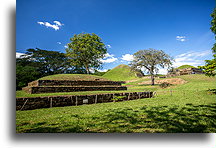This city marked the southernmost area inhabited by the Maya people and at the same time the extreme south of the Mesoamerican cultural region. San Andrés was on the frontier with the Isthmo-Colombian cultural area, which stretches from here south through Central American isthmus to northern Colombia.


The small archaeological site in El Salvador had very limited studies so far. It is known that the occupation in this region began around 900 BC and was interrupted by a volcanic eruption in AD 250. The city prospered again between AD 600 and 900. At that time, San Andrés was the local capital with a population of probably 12,000 residents. The city had trade connections with other important Maya centers of power, such as Tikal and Caracol. but the strongest ties existed with Copán.


Only two pyramids and one ceremonial terrasse in San Andrés have been partially reconstructed. You need to use the imagination to see the vast expanse of the old city. Current archeological evidence indicates that city’s ceremonial center had a large acropolis—part of the city exclusively for upper class—and was divided into two separate political seats. All the major structures were surrounded by a residential area.




